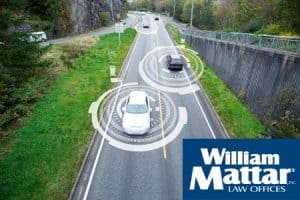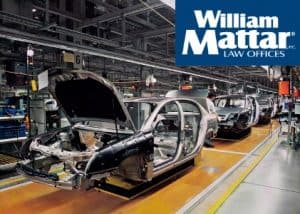
For many people, the self-driving car is a symbol of the future. The concept of getting into a vehicle and never having to take ahold of the steering wheel may seem like science fiction. What you may not know is that there are partially-autonomous vehicles on the road already, and the introduction of a fully-autonomous vehicle may not be that far away.
The companies moving forward with the development of fully self-driving cars believe that it will increase safety and help reduce traffic collisions caused by human error. But as new driving assistance technology is introduced, there will always be the potential for self-driving vehicle accidents.
As with any motor vehicle accident, a self-driving car collision can result in serious injuries. If you’ve sustained in an injury while riding in a driverless vehicle, contact William Mattar law offices today. Our attorneys are available 24/7 to take your call—dial (844-noswap444-4444 .
How do Self-Driving Cars Work?
There are many different iterations of self-driving vehicles, and each one works differently. In general, self-driving systems use some combination of robotic technology and “machine learning” (an artificial intelligence tool) to navigate through their surroundings.
Self-driving software typically incorporates “hard-coded rules, obstacle avoidance algorithms, predictive modeling, and ‘smart’ object discrimination” to operate on roadways. While many systems have autonomous features, some self-driving cars may require a driver to intervene and take control of the vehicle in certain situations.
Here is a breakdown of the basic technology that makes up a self-driving car:
- Lidar: A spinning object on the top of a driverless car that creates 3D models of the surrounding environment. Lidar fires laser beams off of objects to measure the distance using the speed of light.
- Cameras: Used for reading traffic signals and taking images of the roadways to navigate. Cameras can identify things such as speed limit signs and stop lights.
- Radar: Bounces radio waves off objects in close proximity to measure their size, distance, and speed. Radar is often used to spot other vehicles on the road.
- GPS: While lidar and cameras can construct maps of a vehicle’s surrounding area, GPS uses satellite signals to create “preliminary maps” for travel.
- Ultrasonic sensors: Uses sound waves to locate objects in the vicinity, such as curbs.
The Levels of Driverless Cars
Self-driving cars can be divided up into different levels of autonomy. These levels are often categorized on a scale of 0-5.
- Level 0: There’s no autonomy—a driver must control all systems of the car.
- Level 1: Some systems may be automated one at a time, such as cruise control. A driver must still control the car.
- Level 2: At least two systems may be automated simultaneously, such as acceleration and steering. But the driver must still operate the car.
- Level 3: All “safety-critical functions” are automated under specific conditions. A driver is not required to monitor for safety risks, but must be ready to take control of the vehicle when alerted.
- Level 4: All systems are fully autonomous under specific conditions. A driver may or may not have the option to control the vehicle.
- Level 5: All systems are fully autonomous at all times. A driver may or may not have the option to control the vehicle.
No matter the level of autonomy, self-driving cars come with safety risks. When using an automated system in your own vehicle, exercise caution and safe driving practices at all times.
Companies Producing Self-Driving Cars

Self-driving car technology is always evolving— these vehicles are being tested and used in many different sectors. Car manufacturers are racing to develop their own versions of the driverless vehicle to be made commercially available. It’s possible that fully autonomous vehicles could be for sale to the general public within the next few years.
Currently, there are several companies designing and constructing self-driving cars with various levels of autonomy. Some are even being utilized right now to provide transportation services. A few examples of existing self-driving vehicles include:
- Tesla: Several of Tesla’s vehicles, including the Model S and Model X, come with a semi-autonomous driving system known as “autopilot.” Autopilot offers certain self-driving capabilities which vary from car to car. These include features that will steer, park, and change lanes without the direction of a driver.
- Waymo: The driving technology company founded by Google—Waymo—is currently testing fully autonomous vehicles. They also offer a commercial service called Waymo One in Phoenix, Arizona, which transports passengers using a driverless cars.
- Volvo: Since 2006, Volvo has been incorporating autonomous driving features into their vehicle models, including automatic braking. The company claims their first “unsupervised autonomous” cars will be on the market by 2021.
- May Mobility: Michigan-based transportation company, May Mobility, offers an autonomous shuttle service that is currently operating.
The self-driving industry is growing every day. In addition to the above companies, researchers elsewhere are also building autonomous transportation services that are not yet available. Some claim that the advent of these vehicles will help the environment and decrease pollution.
Liability in a Self-Driving Driving Accident
You may find yourself in a semi- or fully-autonomous vehicle at some point in your life. In fact, your current vehicle may already have driving assistance capabilities. However you end up in a self-driving car, there’s always a risk that you could be involved in a driverless car accident.
Proving liability in a self-driving accident case is important to pursuing compensation for a serious injury. As a driver or passenger, the incident that resulted in your injuries may have been completely out of your control. An accident attorney can look closely at the details of your case and help determine whether or not the driverless car was at fault for the accident.
If this is the case, you may be entitled to compensation. The manufacturer that created the vehicle may be responsible for your accident, and therefore your claim will likely be against that vehicle manufacturer. There are also emerging laws surrounding self-driving vehicles that may play a role in your case. Your self-driving car accident lawyer can evaluate your situation with these applicable laws in mind.
Contact an Experienced Self-Driving Car Accident Lawyer
If you’ve been injured in a self-driving car crash, you may have a case. Contact William Mattar law offices to speak to a self-driving car accident lawyer about your options. We offer our No Fee Until We WinSM to our clients which says that you will not owe attorney’s fees unless we win or settle your case. Call 844-noswap444-4444 today.
 How can I help you?
How can I help you?